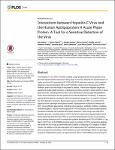Interactions between Hepatitis C Virus and the Human Apolipoprotein H Acute Phase Protein: A Tool for a Sensitive Detection of the Virus
Stefas, Ilias
Tigrett, Sylvia
Dubois, Grégor
Kaiser, Marco
Lucarz, Estelle
Gobby, Delphine
Bray, Dorothy
Ellerbrok, Heinz
Zarski, Jean Pierre
Veas, Francisco
The Hepatitis C virus (HCV) infection exhibits a high global prevalence frequently associated with hepatocellular carcinoma, taking years to develop. Despite the standardization of highly sensitive HCV quantitative RT-PCR (qRT-PCR) detection methods, false-negative diagnoses may be generated with current methods, mainly due to the presence of PCR inhibitors and/or low viral loads in the patient’s sample. These false-negative diagnoses impact both public health systems, in developing countries, and an in lesser extent, in developed countries, including both the risk of virus transmission during organ transplantation and/or blood transfusion and the quality of the antiviral treatment monitoring. To adopt an appropriate therapeutic strategy to improve the patient’s prognosis, it is urgent to increase the HCV detection sensitivity. Based upon previous studies on HBV, we worked on the capacity of the scavenger acute phase protein, Apolipoprotein H (ApoH) to interact with HCV. Using different approaches, including immunoassays, antibody-inhibition, oxidation, ultracentrifugation, electron microscopy and RT-PCR analyses, we demonstrated specific interactions between HCV particles and ApoH. Moreover, when using a two-step HCV detection process, including capture of HCV by ApoH-coated nanomagnetic beads and a home-made real-time HCV-RT-PCR, we confirmed the presence of HCV for all samples from a clinical collection of HCV-seropositive patients exhibiting an RT-PCR COBAS® TaqMan® HCV Test, v2.0 (COBAS)-positive result. In contrast, for HCV-seropositive patients with either low HCV-load as determined with COBAS or exhibiting HCV-negative COBAS results, the addition of the two-step ApoH-HCV-capture and HCV-detection process was able to increase the sensitivity of HCV detection or more interestingly, detect in a genotype sequence-independent manner, a high-proportion (44%) of HCV/RNA-positive among the COBAS HCV-negative patients. Thus, the immune interaction between ApoH and HCV could be used as a sample preparation tool to enrich and/or cleanse HCV patient’s samples to enhance the detection sensitivity of HCV and therefore significantly reduce the numbers of false-negative HCV diagnosis results.
Dateien zu dieser Publikation
Keine Lizenzangabe

